Race Car Aerodynamics Explained: 7 Powerful Winning Secrets 2025
Why Understanding Race Car Aerodynamics is the Key to Speed
Race car aerodynamics explained starts with one simple fact: air isn’t empty space. When a car moves through air at high speeds, it creates invisible forces that can make or break lap times.
Here’s what you need to know about race car aerodynamics:
- Drag – Air resistance that slows the car down (like an invisible parachute)
- Downforce – Air pressure that pushes the car toward the track for better grip
- Ground Effect – Using the car’s underbody to create a low-pressure zone
- Trade-offs – More downforce usually means more drag, requiring careful balance
- Speed Matters – Aerodynamic forces increase by four times when speed doubles
Modern Formula 1 cars can generate four times their own weight in downforce at top speed. That’s enough force to theoretically drive upside down on a tunnel ceiling. But here’s the catch – all that downforce comes with drag that fights against the engine’s power.
The magic happens in finding the perfect balance. Too much downforce and you’re slow on the straights. Too little and you can’t corner fast enough. Every successful race car is a carefully tuned compromise between these competing forces.
At speeds as low as 50 mph, aerodynamics starts affecting your car’s behavior. By 100 mph, aerodynamic forces dominate everything – from tire grip to fuel consumption.
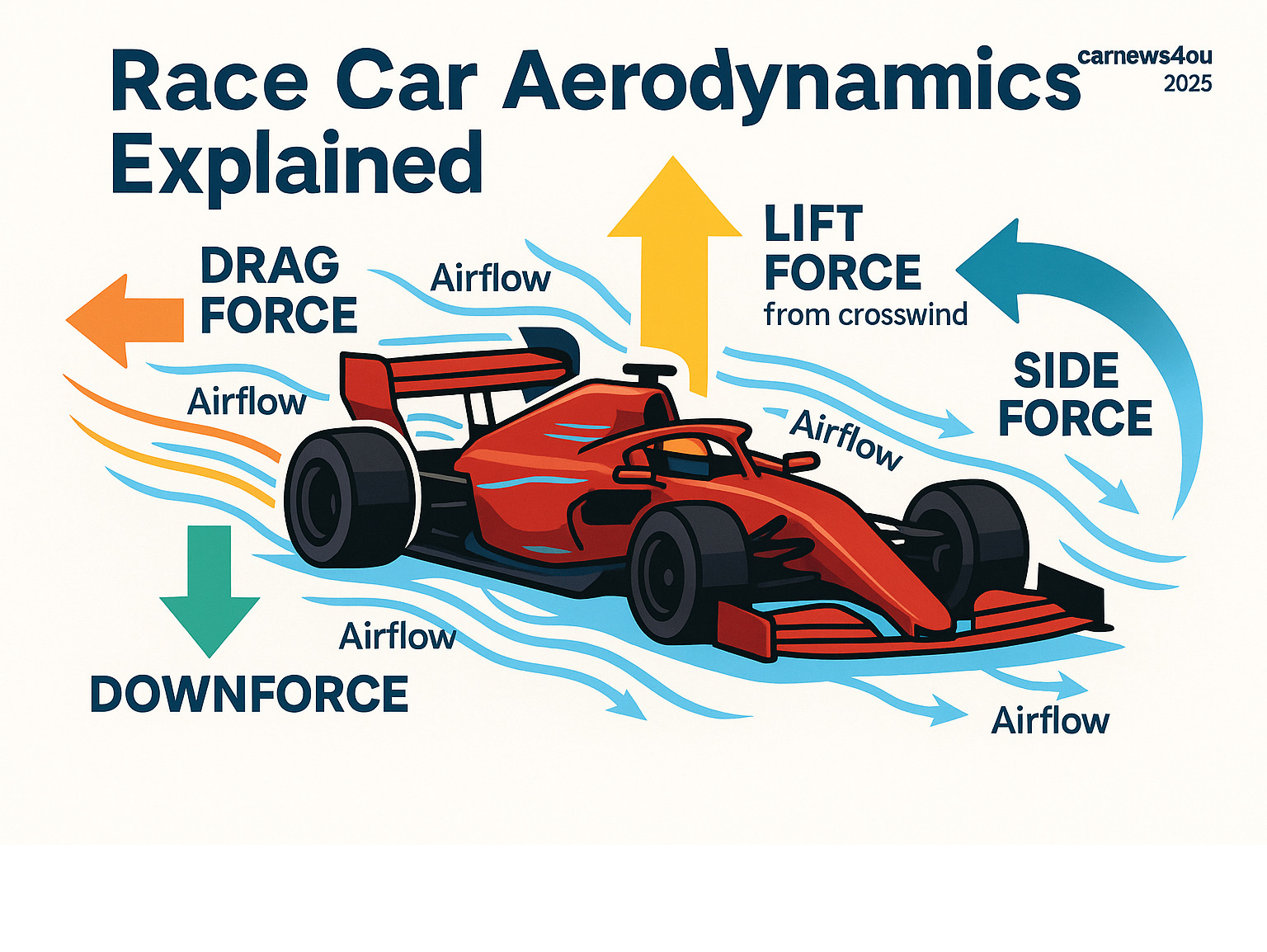
Find more about race car aerodynamics explained:
Aerodynamics 101: Forces Shaping Speed

When you watch a race car slice through the air at 200 mph, you’re witnessing an invisible battle between the car and the atmosphere. Race car aerodynamics explained comes down to understanding how air behaves around moving objects.
Air isn’t empty space. It’s a fluid that pushes, pulls, and swirls around every surface of a moving car. When engineers design race cars, they’re essentially sculpting the air to work for them instead of against them.
The foundation of all aerodynamic design traces back to Bernoulli’s principle – faster-moving air creates lower pressure. This simple concept explains everything from airplane wings to race car diffusers.
Aerodynamic forces follow the speed-squared law. Double your speed from 50 mph to 100 mph, and the aerodynamic forces increase by four times. This is why aerodynamics barely matters in daily driving but becomes the dominant factor on race tracks.
Drag: The Invisible Parachute
Imagine driving with an invisible parachute attached to your car – that’s exactly what drag feels like to a race car engine. Pressure drag creates the biggest headache for race car designers. It happens when high-pressure air at the front meets the low-pressure wake behind it.
Skin friction adds up quickly across every square inch of the car’s surface. The real troublemaker is interference drag from those beautiful open wheels that define Formula 1 cars – each spinning wheel creates a tornado of turbulent air.
Despite all their advanced aerodynamics, F1 cars have a minimum drag coefficient (Cd) of about 0.75. Compare that to your family sedan at around 0.28, and you realize how much those open wheels and wings cost in terms of drag.
Downforce: Turning Air Into Grip
Downforce is essentially upside-down lift. Instead of making the car want to fly, engineers use aerodynamics to push it harder into the track surface. This directly translates to grip – more downward force means more traction for cornering, braking, and acceleration.
Modern race cars can corner at forces approaching 4g – four times the force of gravity. Without aerodynamic downforce, this would be impossible. At high speeds, aerodynamic downforce can exceed the car’s weight by a huge margin.
The Drag-Downforce Trade-off
Here’s the cruel reality: downforce and drag are married to each other. Most devices that create downforce also create drag, forcing engineers into a constant balancing act.
The L/D ratio (lift-to-drag ratio) becomes the holy grail of aerodynamic design. Different tracks demand different compromises. At high-speed circuits like Monza, teams run minimal downforce to reduce drag. At tight circuits like Monaco, they load up on downforce to improve cornering speed.
For more insights into fundamentals of aerodynamics, this comprehensive resource covers the scientific principles behind race car design.
Race Car Aerodynamics Explained: Key Devices and How They Work
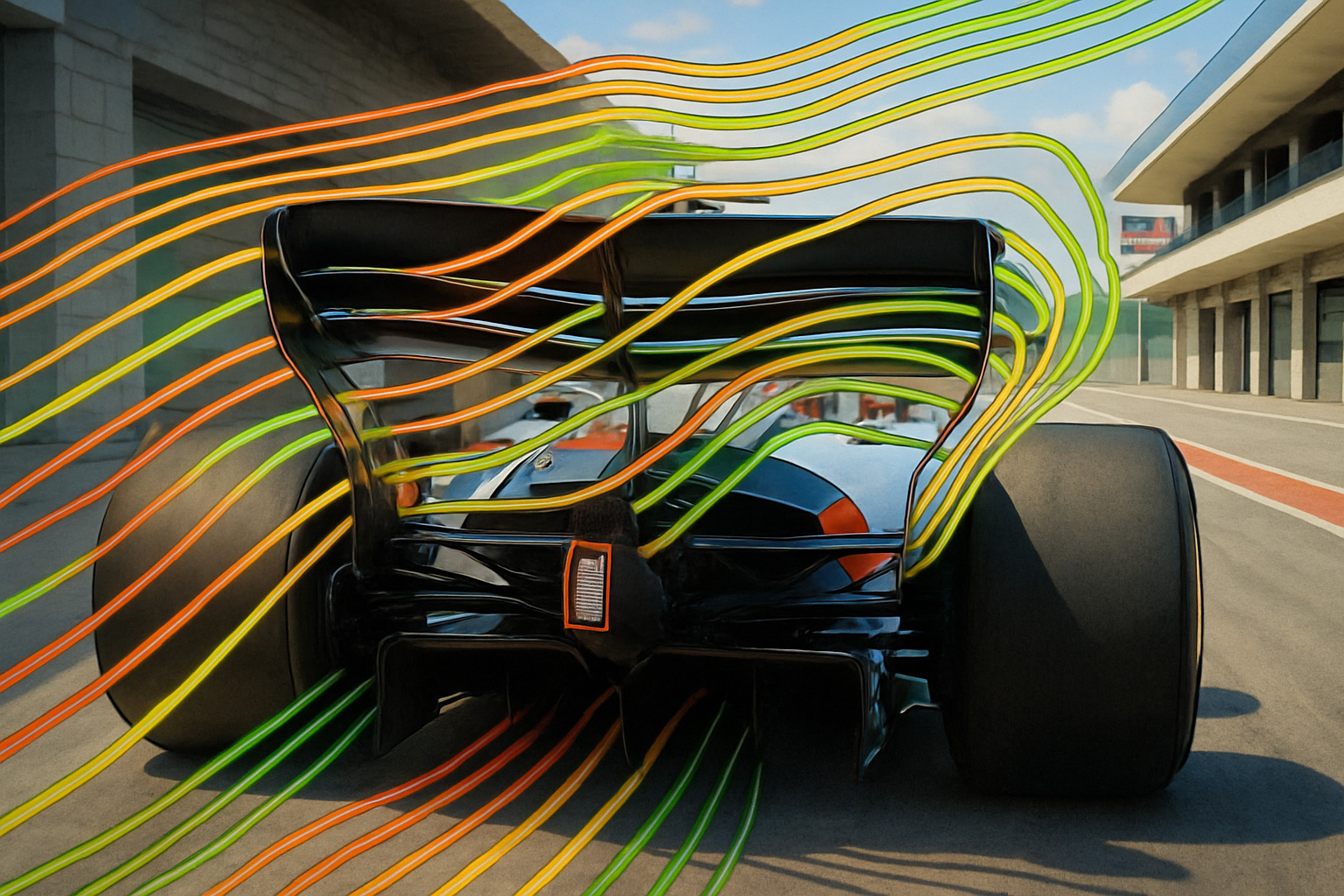
Here’s where race car aerodynamics explained gets really interesting. Each aerodynamic device on a race car has a specific job, and they all work together like instruments in an orchestra.
| Device | Primary Function | Drag Impact | Downforce Efficiency |
|---|---|---|---|
| Wings | Generate downforce | High | Moderate |
| Spoilers | Prevent lift | Low | Low |
| Diffusers | Generate downforce | Very Low | Very High |
| Splitters | Create front downforce | Moderate | Moderate |
| Ground Effect | Generate downforce | Low | High |
Wings & Spoilers – Race Car Aerodynamics Explained in the Air
Wings and spoilers look similar, but they’re completely different. A wing is like an upside-down airplane wing that actively creates downforce by pushing air upward. A spoiler is more like a wall that blocks unwanted airflow patterns.
Wings use the same physics as aircraft wings, just flipped over. The wing’s curved shape makes air flow faster over the top surface than the bottom, creating lower pressure above the wing. The angle of attack is crucial – tilt the wing too much, and the airflow separates from the wing surface, causing it to stall.
Multi-element wings use precisely positioned slots between wing sections to keep airflow attached at steeper angles. Those vertical panels on the wing tips are called endplates, preventing high-pressure air from sneaking around the wing tips.
Spoilers work differently – they “spoil” lift-creating airflow patterns. They’re less efficient than wings but simpler and often required by racing regulations.
Ground Effect & Diffusers – Race Car Aerodynamics Explained Under the Floor
Ground effect is the secret weapon of modern race car aerodynamics. It’s arguably the most efficient way to generate downforce, happening underneath the car where you can’t see it.
The principle is simple: create a low-pressure zone under the car by forcing air to speed up through a narrow space. Venturi tunnels under the car squeeze air through the narrow section (speeding it up and lowering pressure), then exit through the diffuser at the rear.
The diffuser is the expanding section at the rear that allows fast-moving air to slow down and expand. This creates even lower pressure under the car while directing airflow upward. Diffusers can generate massive downforce with very little drag penalty.
But ground effect is sensitive. Ride height is critical – if the car rises just 20mm off the ground, you can lose up to 50% of underbody downforce.
Splitters, Canards, Skirts: Fine-Tuning Front Grip
Front splitters are the horizontal blade at the front creating high pressure above while preventing air from flowing underneath. This generates front downforce and helps seal the underbody for ground effect.
Canards look like tiny wings on the front bumper. They generate some downforce but their real job is creating vortices – spinning columns of air that help energize airflow to other parts of the car.
Side skirts are vertical panels that seal the sides of the car’s underbody, preventing high-pressure air from entering the low-pressure zone under the car.
Measuring and Optimising Aerodynamics

Here’s where race car aerodynamics explained gets really interesting – the detective work of figuring out what actually works. The tricky part is that air is invisible, so racing teams have developed sophisticated ways to measure and understand airflow around their cars.
Modern aerodynamic development uses three main approaches: wind tunnels, computational fluid dynamics, and track testing.
Wind Tunnels & Scale Models
Wind tunnels are like aerodynamic laboratories where engineers can control everything. Most professional racing teams use 60% scale models – precision instruments that can cost hundreds of thousands of dollars.
Modern racing wind tunnels use moving ground belts to simulate the track surface and rotating wheels to replicate real-world conditions. Force balances can measure aerodynamic forces down to fractions of a pound.
Smoke visualization makes the invisible visible. Engineers inject smoke into the airflow to see exactly how air moves around the car. You can watch airflow separate from surfaces, see vortices form, and understand why modifications work or don’t work.
The beauty of wind tunnels is control and repeatability. Engineers can test one specific change at a time in perfectly consistent conditions.
Computational Fluid Dynamics
CFD has revolutionized aerodynamic development. Using powerful computers, engineers can simulate airflow around a car without building anything physical. It’s like having a virtual wind tunnel that never closes.
Modern CFD can model incredibly complex phenomena – how airflow changes through corners, different weather conditions, and even how airflow from one car affects another during close racing.
The speed of CFD is its biggest advantage. What might take days to test in a wind tunnel can be simulated overnight. This rapid iteration capability has accelerated aerodynamic development dramatically.
Track Testing & Data
The track is where aerodynamics really matter. Modern race cars are rolling laboratories equipped with aero load cells in the suspension that measure downforce in real-time. Pressure taps around the car monitor airflow conditions.
More info about telemetry systems
One simple track testing method is tuft-testing – taping short pieces of yarn to the car’s surface and filming how they behave at speed. When airflow is smooth, tufts lie flat. When airflow separates, tufts flutter chaotically.
The ultimate test is lap-time delta – the difference in lap times between different aerodynamic configurations. A change that looks promising in the wind tunnel but doesn’t improve lap times isn’t worth making.
Evolution, Regulations and Real-World Impact
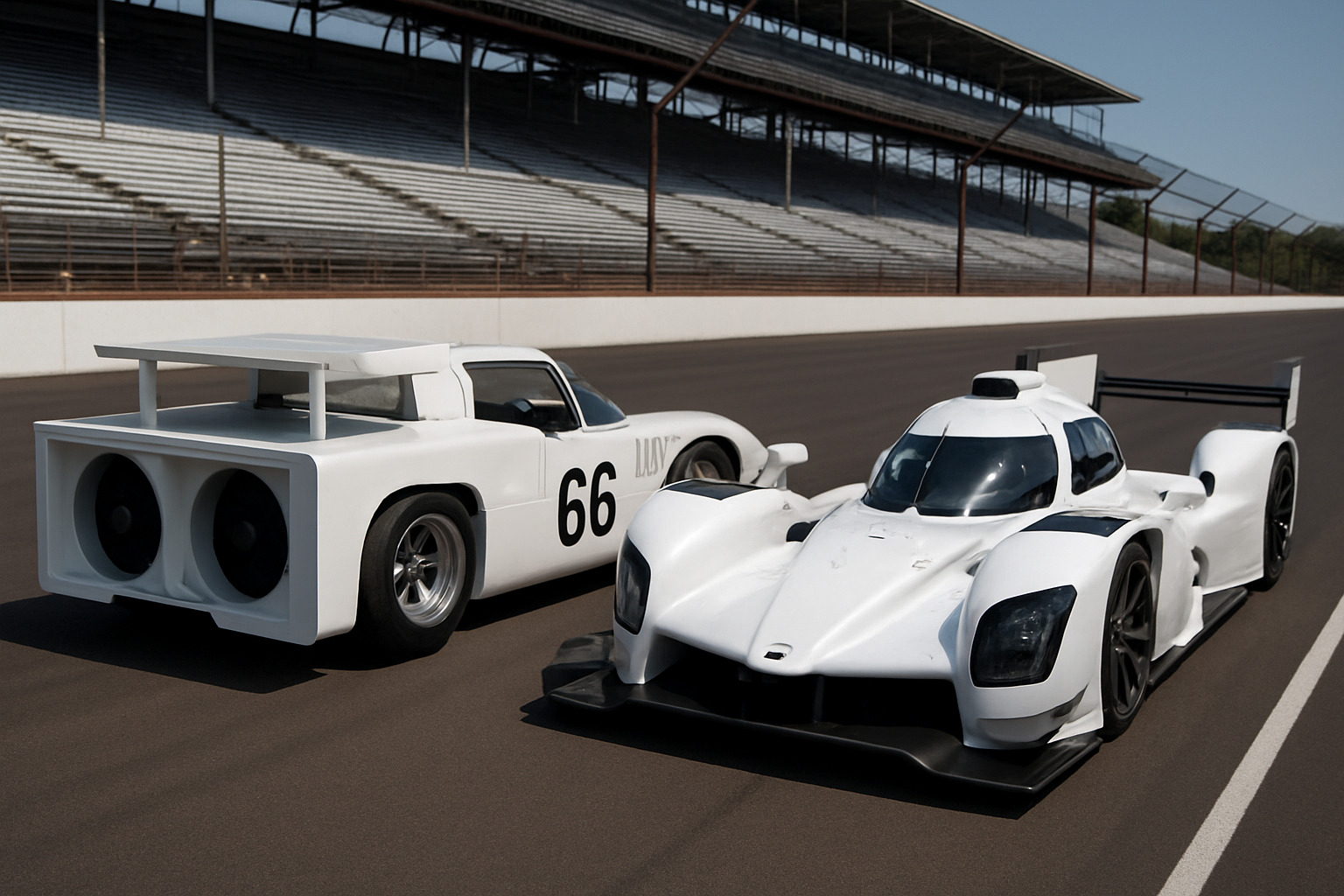
The story of race car aerodynamics explained reads like a thrilling novel filled with brilliant innovations and constant battles between engineers and rule makers.
Milestones in Aero Development
In 1966, Jim Hall’s Chaparral 2E showed up with something nobody had seen before – a massive wing mounted high above the car. Other teams laughed until they saw the lap times.
The Lotus 78 changed everything in 1977. Colin Chapman’s design used shaped sidepods to turn the entire car into a giant wing, generating downforce that allowed cornering forces of nearly 4g.
The most outrageous creation was the Brabham BT46B – the infamous “fan car.” Gordon Murray’s team mounted a huge fan that sucked air from under the car. The downforce was so enormous the car could theoretically stick to the track upside down. It won its only race before being banned.
How Rules Shape the Air
Every major aerodynamic breakthrough has led to new rules. Safety concerns have driven many changes. Wing failures in the late 1960s led to strict mounting requirements. Ground effect was banned in Formula 1 after several accidents showed what happens when cars lose aerodynamic grip suddenly.
Different racing series take different approaches. Formula 1 has incredibly detailed regulations specifying exactly where wings can be placed. NASCAR uses a “common template” approach. Sports car racing uses Balance of Performance systems to level the playing field.
Lap-Time Gains From Aero
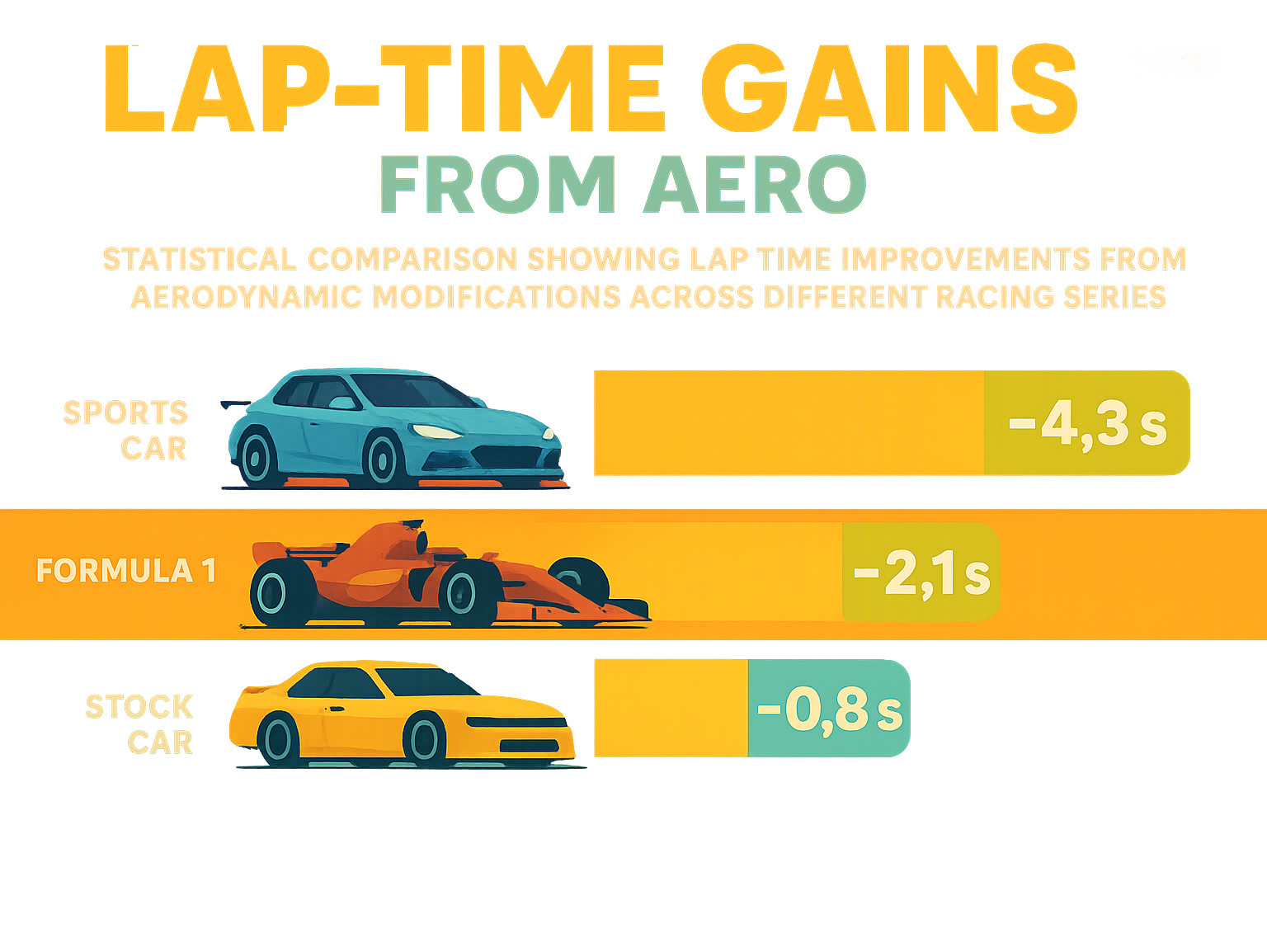
The numbers tell an incredible story. A simple Mazda Miata with aerodynamic modifications dropped 4.5 seconds per lap at Mid-Ohio compared to a stock car. The stock Miata ran 104.60 seconds, but with a basic aero kit it dropped to 101.12 seconds.
Formula 1 cars can decelerate at over 1g simply by lifting off the throttle – the aerodynamic drag is so significant that drivers can slow down faster than most road cars can brake.
NASCAR’s roof flaps deploy automatically when a car spins, spoiling airflow and preventing dangerous lift-off. It’s aerodynamics working backwards, intentionally destroying forces that could turn a race car into an airplane.
Scientific research on race-car history
Frequently Asked Questions about Race Car Aerodynamics Explained
What is a good drag coefficient for a race car?
There’s no single “good” drag coefficient for race cars – it depends entirely on the racing application.
Road cars achieve around 0.28 for efficiency. Le Mans prototypes run 0.30-0.40, balancing top speed with cornering grip. NASCAR stock cars clock in around 0.39. Formula 1 cars have a minimum of 0.75, nearly three times worse than road cars, but they’re generating massive downforce.
The lesson? Race car aerodynamics explained isn’t about finding the lowest drag coefficient – it’s about finding the right balance for your specific racing needs.
How does a diffuser create downforce with little drag?
Think of a diffuser as nature’s vacuum cleaner. Air enters the narrow space under your car’s floor and speeds up. According to Bernoulli’s principle, faster air means lower pressure under the car.
The diffuser gradually expands this fast-moving air, like a trumpet bell. This expansion maintains the low-pressure zone under the car while cleaning up the car’s wake. You get a suction effect that pulls the car toward the track without creating the messy airflow disruptions that wings cause.
The catch? Diffusers are incredibly sensitive to ride height. Change the gap by just 20mm, and you can lose up to 50% of your downforce.
Why do wings sometimes ‘stall’ in a corner?
Wing stall is like a tire losing grip – it happens suddenly and dramatically. Every wing has a critical angle of attack – typically around 22 degrees. Push beyond this angle, and smooth airflow breaks down into chaotic turbulence. Downforce drops while drag shoots up.
In corners, body roll and pitch change the wing’s angle relative to airflow. Airflow disruption from side slip angles or interaction with other devices can mess with the smooth airflow wings need. There’s also the speed factor – in slow corners, reduced airflow makes wings less effective and more prone to stall.
Modern wings fight stall with multi-element designs that use slots to energize airflow, allowing steeper angles without stalling.
Conclusion
When we started exploring race car aerodynamics explained, we dove into an invisible world where air becomes both friend and enemy. Every race car slicing through the air at 200 mph is locked in a constant battle with physics – a battle that determines who wins and who goes home disappointed.
The journey from early Chaparral experiments to today’s sophisticated Formula 1 machines shows how far we’ve come. What began as simple streamlining has evolved into a complex dance of pressure zones, venturi tunnels, and multi-element wings working together to squeeze every tenth of a second from lap times.
The numbers tell the story best. That Miata we discussed – nearly 4.5 seconds faster per lap with proper aerodynamics. In racing terms, that’s the difference between winning and watching from the pits.
What strikes me most about aerodynamics is how it captures the essence of racing engineering. Every decision is a compromise. More downforce means more grip but also more drag. The magic happens when engineers find that sweet spot where everything works together.
Ground effect remains the most neat solution – using the car’s underbody to create a low-pressure zone that sucks the car to the track. It’s efficient, powerful, and can generate enough force to theoretically hold a car to a tunnel ceiling.
The future looks fascinating. Active aerodynamic systems are becoming more sophisticated, regulations continue to evolve, and sustainability is driving innovation. The reintroduction of ground effect in Formula 1 shows that sometimes the best path forward involves revisiting brilliant ideas from the past.
At Car News 4 You, we love these stories where cutting-edge technology meets the fundamental human desire to go faster. Aerodynamics embodies everything we’re passionate about – the intersection of automotive innovation and racing performance, where milliseconds matter and every detail counts.
Whether you’re planning your first track day or setting up a race car, these principles apply. The air doesn’t care if you’re driving a weekend warrior or a million-dollar prototype. Physics treats everyone equally – it’s up to us to work with it rather than against it.
The next time you watch a race, some of the most important action is happening in the invisible world around each car. Those carefully sculpted wings, precisely angled splitters, and hidden diffusers are all working together in a symphony of airflow.
For more insights into the technology that makes racing possible, check out our comprehensive resource guide where we dive deep into everything from telemetry systems to suspension tuning.
The pursuit of aerodynamic perfection never ends. As long as there are races to win and records to break, engineers will keep pushing the boundaries of what’s possible when science meets speed.

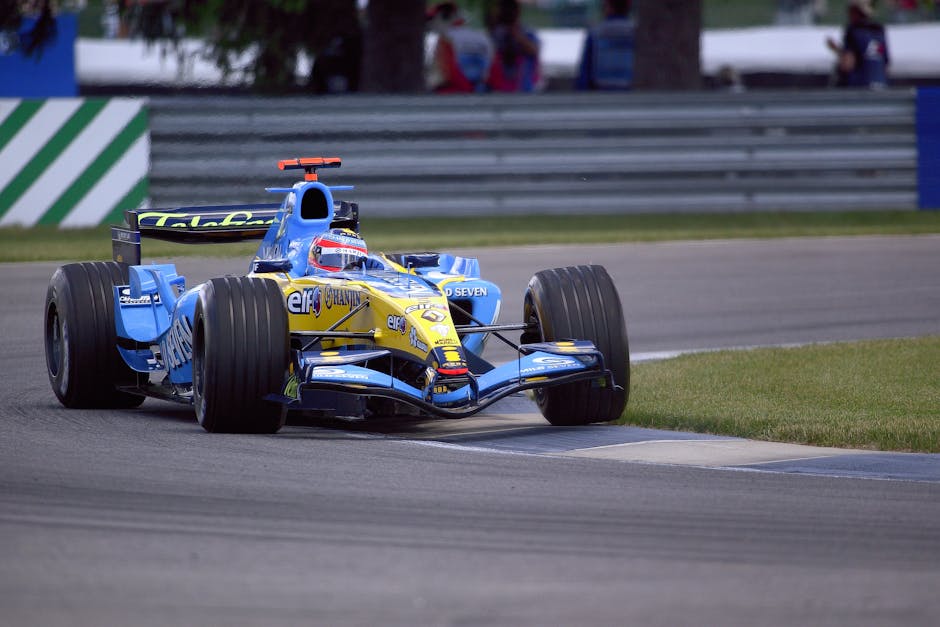






1 thought on “The Fast and the Curious: A Guide to Race Car Aerodynamics”
Pingback: Step-by-Step Guide to Racing Car Techniques for Beginners - Car News 4 You
Comments are closed.